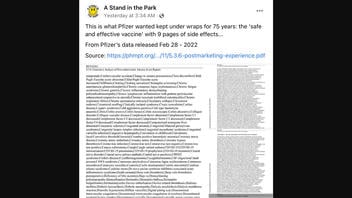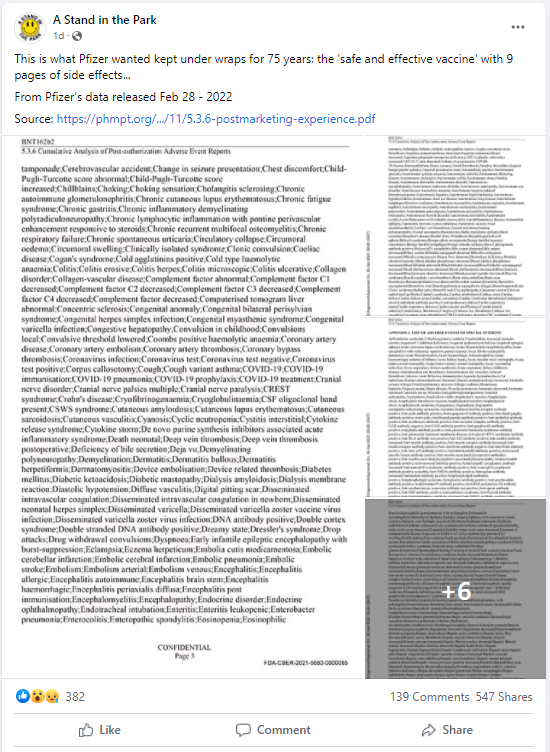
Does a Pfizer document list thousands of side effects from its COVID-19 vaccine? No, that's not true: The nine pages of potential side effects are part of a government-required adverse event (AE) report prepared by the pharmaceutical company. It's not meant to be a list of the expected side effects from the shot, but instead, "expert groups and regulatory authorities" put together the possible side effects for safety monitoring purposes.
The claim appeared in a Facebook post (archived here) on March 2, 2022. It opens:
This is what Pfizer wanted kept under wraps for 75 years: the 'safe and effective vaccine' with 9 pages of side effects...From Pfizer's data released Feb 28 - 2022
(Source: Facebook screenshot taken on Thu Mar 3 18:16:41 2022 UTC)
Although the Facebook post claims the Pfizer document was released on February 28, 2022, it's the same document Lead Stories examined in a similar story we debunked on December 3, 2021.
The Pfizer document was part of a Freedom of Information Act request by a group of more than 30 professors and scientists from universities including Harvard, Yale, Brown and UCLA. In their lawsuit filed September 16, 2021, the plaintiffs asked the FDA to share the data it relied upon in licensing Pfizer's COVID vaccine.
The document, called 5.3.6 CUMULATIVE ANALYSIS OF POST-AUTHORIZATION ADVERSE EVENT REPORTS OF PF-07302048 (BNT162B2) RECEIVED THROUGH 28-FEB-2021, was approved on April 30, 2021, according to the timestamp on the side of the PDF.
What the Facebook post describes as "9 pages of side effects" are known as adverse events of special interest (AESIs), which are included in APPENDIX 1, starting on Page 30. A definition of the term is part of a U.S. Food and Drug Administration (FDA) document on the "Optimisation of Safety Data Collection" for new drugs and medicines that are being licensed. This is how the FDA defines AESIs:
These adverse events may warrant collection of additional information across the entire study population to better characterise these events (e.g., particular laboratory parameters; vital signs; risk factors; concomitant therapies; and/or concomitant illnesses).
At the time the Pfizer document was submitted, their vaccine was under emergency use authorization.
The AESI list was put together by the Brighton Collaboration, ACCESS protocol, the U.S. Centers for Disease Control and Prevention and the U.K. Medicines and Healthcare products Regulatory Agency.
In a March 3, 2022, email to Lead Stories, Keanna Ghazvini with Pfizer global media relations provided this statement from the company:
We take adverse events that are potentially associated with our COVID-19 vaccine, BNT162b2, very seriously. We closely monitor all such events and collect relevant information to share with global regulatory authorities. It is important to note that serious adverse events that are unrelated to the vaccine are unfortunately likely to occur at a similar rate as they would in the general population. With hundreds of millions of doses of the Pfizer-BioNTech COVID-19 vaccine administered globally, the benefit risk profile of our vaccine remains positive for all approved indications and age groups. Pfizer continues to monitor trial participants' health for two years after vaccination. In addition, we continue to perform post-authorization safety surveillance. Government and regulatory authorities, such as the Centres for Disease and Control (CDC), also conduct safety surveillance.
Most of the numbers reported in the Pfizer document come from expert groups and regulatory authorities, including European health organizations and the Vaccine Adverse Event Reporting System (VAERS) in the United States, which is run by the Centers for Disease Control and Prevention and the FDA.
Lead Stories has debunked several claims about vaccine deaths that misuse VAERS.
Anyone with internet access can add a report to the VAERS list of reports. The public access link to it expressly warns against unwarranted conclusions based on VAERS material because the list only provides a tally of unverified notes about any health event people experience after they are vaccinated.
The list itself cannot be used to prove or quantify, since all it shows is a chronological correlation, not the causal link that would be more difficult to establish. It's the equivalent of a police precinct's running "blotter" of reports that may serve as a starting point for police work, not an endpoint.













